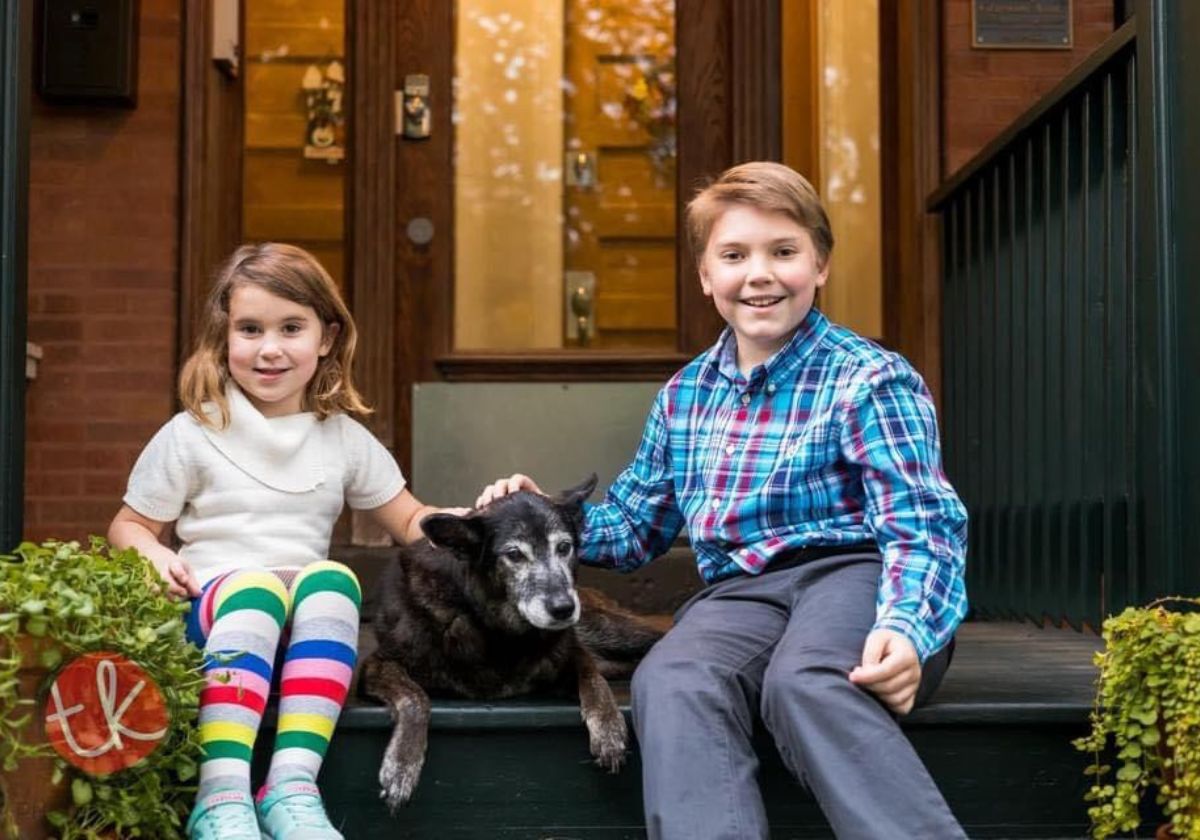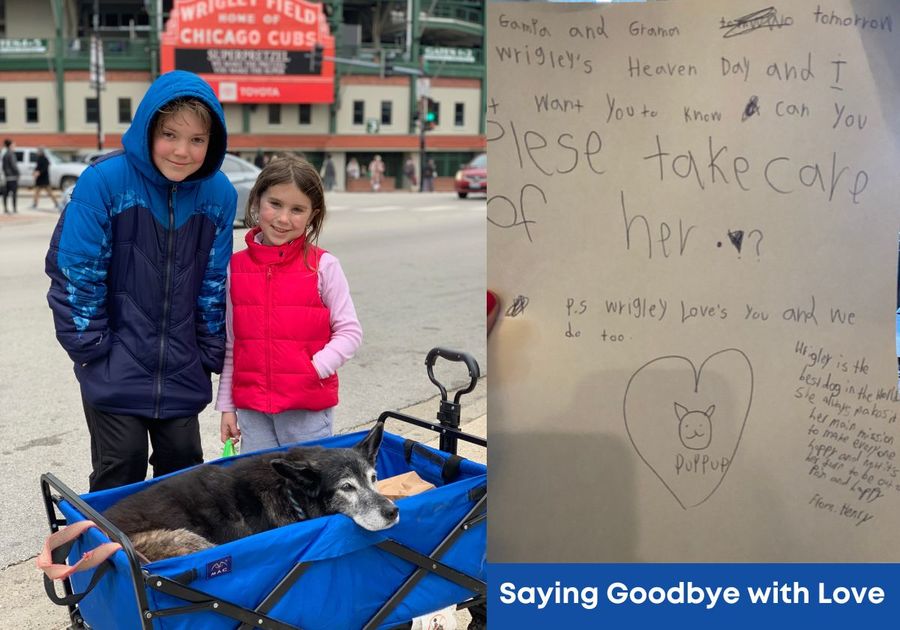For many families, pets are more than just animals; they are beloved companions and cherished members of the family. The loss of a pet can be a deeply emotional experience, especially for children who have formed strong bonds with their furry friends. As parents, it's essential to provide guidance and support during this challenging time. We navigated the sensitive topic of saying goodbye to a beloved pet this year and I hope that by sharing our experience may help another family in the same position.
Open Communication: Honest and open communication is key when addressing the loss of a pet. Create a safe space where your child feels comfortable expressing their feelings. Encourage them to share memories, stories, and emotions related to their pet. Let them know that it's natural to feel sadness, and reassure them that their feelings are valid.
In our family, we discussed in a very open and direct way our dog and her current health. We shared the things we each noticed:
"Wrigley didn't stand up when I woke up this morning, but she did wag her tail when I snuggled her"
"Wrigley went potty while she was sleeping. Again"
"Last night Wrigley didn't notice or recognize me until I turned on the lights and got closer to her"
Understanding Grief: Just like adults, children experience grief in their own unique ways. Some may be openly expressive, while others might withdraw. Allow your child to process their emotions in their preferred manner, without judgment. Be patient and offer comfort when they need it.
Knowing my own family would need time to process their feelings and thoughts, we began talking about the death of our dog several weeks before the appointment for euthanasia was even scheduled. It allowed us to have a conversation guided by the kids and not be rushed. I felt the first step would be to acknowledge the reality in front of us.
Explaining Death: Use age-appropriate language to explain the concept of death to your child. Avoid using euphemisms or confusing explanations. Be honest and straightforward while considering their level of comprehension.
It is also okay to say, "I don't know." or "I need a little time so I can answer that in the best way."
I also explained to our kids that when I adopted Wrigley all those years ago I was making a promise to her that I would care for her and that I would help her be loved and comfortable every day of her life, even on the very last day.
Creating Positive Memories: Engaging in a memorial activity can help your child say goodbye in a meaningful way. Planting a tree or flowers, creating a scrapbook, or holding a small ceremony can provide a sense of closure and allow your child to honor the memory of their pet.
We chose to celebrate our pet's amazing life by spoiling her with a special outing. Since her legs were not strong or reliable any longer, we made her a cozy bed in our wagon and took her out to all of her neighborhood favorites: the local pet shop where we picked out a few of her favorite cookies, her favorite restaurant to order her lunch of chicken AND hamburger and from there we pulled her up to her namesake, Wrigley Field, where she got to enjoy her lunch to go. It was emotional, but a wonderful way to let us each have the chance to pour more love into our dog.
Listening and Validating: Listen actively to your child's stories, thoughts, and concerns. Avoid dismissing their feelings or trying to "fix" their sadness. Let them know that you are there to listen and offer comfort when needed.
 |
Time to Say Goodbye: Deciding when it's time to say goodbye to a pet is a difficult decision. Factors to consider include the pet's quality of life, level of suffering, and advice from a veterinarian. Involve your child in the discussion, but ultimately, as a parent, you should make the decision that is best for the pet's well-being. Our vet was amazing and we also used this resource to help us evaluate our dog towards the end of her life.
Preparing for Euthanasia: If the decision is made to euthanize a pet, prepare your child by explaining the process in gentle and honest terms. Reassure them that their pet will no longer be in pain. Allow them to spend quality time with the pet beforehand and be there to comfort them during and after the procedure.
Our home appointment was scheduled on a weekday morning when the kids had the option to be at school and distracted from what is the hardest part of caring for a dog. We gave our oldest, age 11, the choice if he wanted to be present or if he wanted to be at school. He was conflicted until I assured him that it was more than okay as a child to let the parents do the hard stuff. With that reassurance, he chose to go to school. Our youngest, age 6, was not given the option. Personally, we felt that at that stage in life, it would be too much for her, and she spent the day at school filled with the distractions of classes, friends, and recess. Instead, what we did was allow them to prepare a little bag for Wrigley to take on her trip across the Rainbow Bridge. There was a letter written to relatives who had already passed away, asking them to care for our dog and telling them what a good girl she was on Earth. Then they added a couple of our dog's favorite cookies, favorite toys, and a cozy blanket.
Supporting Regrets: Children might express regrets or guilt about the pet's death, even if they weren't directly responsible. Assure them that their feelings are normal and that they provided love and care to their pet throughout its life.
Preserving Memories: Encourage your child to create a memory box, drawing, or letter dedicated to their pet. This can help them keep their pet's memory alive and provide comfort during moments of sadness. Our daughter spent several nights just looking through photos of our dog right after she died. Now after several months have passed she does it less regularly, but the album still gets a good browsing and she asks for us to share stories about Wrigley. The vet who came to perform the euthanasia also created a keepsake paw print for us in clay and the kids have it propped up by a photo of Wrigley.
Seeking Professional Help: If your child is struggling to cope with the loss, consider seeking support from a professional counselor or therapist. Grief is a complex emotion, and a professional can provide tools and strategies to help your child navigate it.
The death of a pet is a heart-wrenching experience, but as parents, we can guide our children through this challenging journey. By fostering open communication, understanding their grief, and making informed decisions together, we can help our children navigate the complexities of pet bereavement. Remember that each child, just like each adult, processes grief differently, so provide a safe and supportive environment for them to express their feelings and find comfort in their own way.



